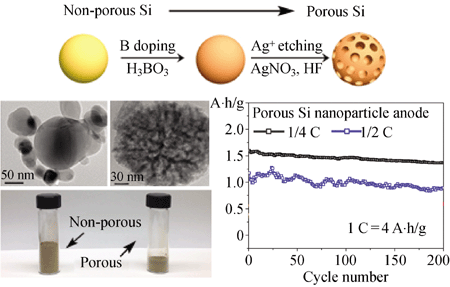We’d all love to see the battery that’s lighter, stronger, charges like a capacitor and costs next to nothing. We’d all be driving electric cars and those of us who wanted battery-powered airplanes would be designing the next new wave of flight.
Usually, these things are a decade or more away, following excruciating intervals of study, commercialization and usually, much-delayed or postponed production.
Dr. Chongwu Zhou, a professor at the University of Southern California’s (USC’s) Viterbi School of Engineering, claims to have such a battery under provisional patent, and potentially available commercially within “two or three years,” according to school press releases.
The battery uses porous silicon nanoparticles to replace traditional graphite anodes and provide superior performance – three times as much energy as a graphite-based lithium battery and capable of being recharged within only 10 minutes.
Zhou says, “It’s an exciting research. It opens the door for the design of the next generation lithium-ion batteries.” Zhou worked with USC graduate students Mingyuan Ge, Jipeng Rong, Xin Fang and Anyi Zhang, as well as Yunhao Lu of Zhejiang University in China. Their research was published in Nano Research in January.
Other attempts to use silicon in battery anodes have met with disappointment because the material expands and contracts on charging and discharging, causing eventual dismantling of the anodes.
Zhou and his team tried a subtle difference, using porous silicon nanowire less than 100 nanometers in diameter and a few microns long. The tiny pores allow expansion and contraction without breaking while increasing the surface area available for reaction with lithium ions, which can move about the internals of the battery freely.
A downside was that mass production of these nanowires proved difficult. In a great workaround, Zhou’s team etched commercially available nanoparticles with the same pores as the nanowires. (Think of stories of people who’d engraved a favorite poem on a grain of rice – only at a sub-microscopic level.) According to USC, the particles function similarly and can be made in any quantity desired.
In another downside, the silicon nanoparticle batteries currently last for just 200 recharge cycles (compared to an average of 500 for graphite-based designs). Hope still reigns, though. The original silicon nanowire-based design lasted for up to 2,000 cycles, as reported in Nano Letters last April and available in Nano Research as a “Just Accepted” paper. Further development of the nanoparticle design should boost the battery’s lifespan, Zhou said.
Zhou hopes for a “real impact on battery applications in the near future,” and is driving his team to develop a high-capacity cathode material to complement their new anode. Such a battery would be a great contribution to the future of the electric vehicle.

